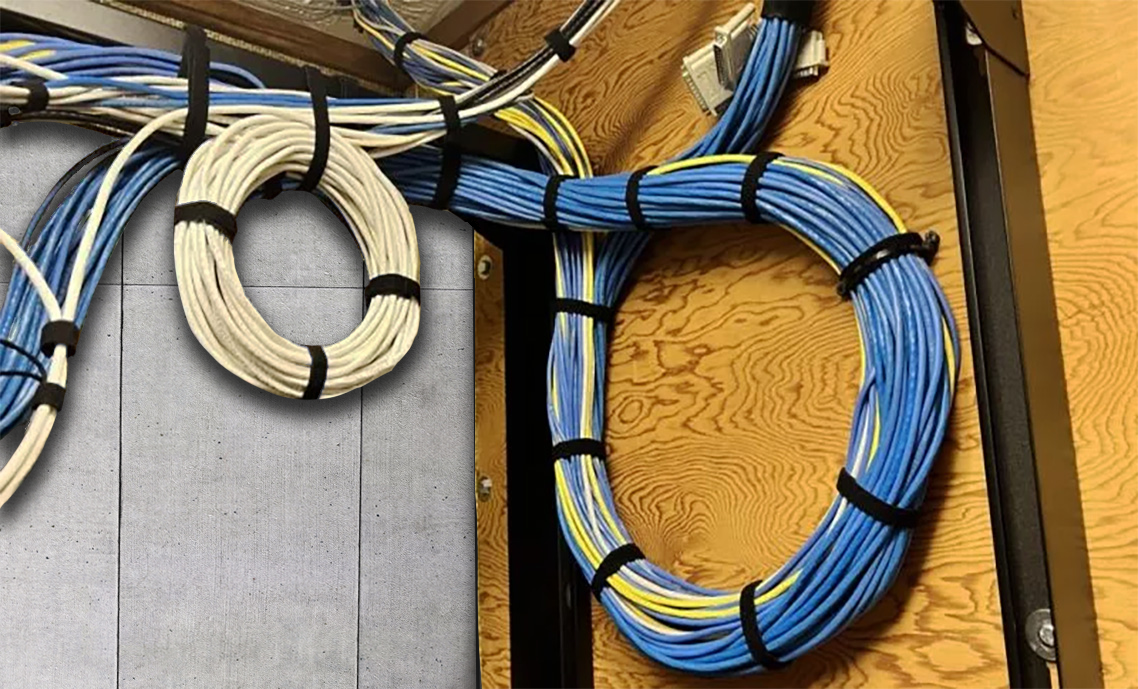
The Loop That Saves the Pull
Service loops are not an afterthought—they’re a strategic asset in structured cabling design. This guide defines best practices for loop placement, length, hardware integration, and audit readiness across copper, fiber, and coaxial systems. Whether you're planning for future AMCs, protecting terminations, or ensuring compliance with bend radius and strain relief standards, properly implemented service loops deliver flexibility without compromising signal integrity.
Every section below is sequenced for field deployment, with labeling, inspection, and documentation protocols locked for specifier and contractor use.
1. Purpose and Strategic Value
- Provides flexibility for adds, moves, and changes (AMCs) without re-pulling cable
- Allows damage recovery via re-termination of connectors if needed
- Acts as a compliance buffer for bend radius and strain relief, especially with fiber and shielded cables
- Facilitates inspection and troubleshooting without cable stress
2. Placement Zones & Best Practices
Best Practice Locations:
- Telecommunications Room: Coiled behind patch panels or inside vertical cable managers
- Work Area Outlet (WAO): Slack neatly tucked behind wall plates or inside boxes
- Ceiling Spaces / Junctions: Loops suspended or laid flat in trays (using plenum-rated cable where required)
- Equipment Racks: Bundled neatly near termination points
3. Loop Lengths by Cable Type
Use the following loop length guidelines by cable type to ensure compliance and maintain signal integrity:
- Copper (Cat5e/6/6A): 12–24 inches per end — Avoid excessive slack to prevent signal degradation
- Fiber Optic: Up to 3 meters per end — Maintain bend radius; use dedicated slack spools for fiber
- Coaxial: 12–24 inches per end — Similar practice to copper; less common in modern builds
4. Hardware Integration for Loop Management
Approved Hardware:
- Hook-and-loop straps: Preferred for bundling; non-abrasive and adjustable
- Magnetic cable holders: Ideal for metal surfaces; UL Listed telecom-grade options available
- Distribution rings: Guide and retain loops in vertical or horizontal managers
- Slack spools: Essential for fiber; preserves bend radius and prevents microbending
- J hooks: Suitable for horizontal runs; loops must be supported without compression
- Cable trays: Loops laid flat or gently coiled; never crammed or stacked
Practices to Avoid:
- Cable ties: Not recommended—risk over-tightening, deformation, and signal issues
- Overstuffed enclosures: Violates airflow and bend radius requirements; loops must remain accessible
- Unlabeled slack: All loops should be documented and traceable for auditing
5. Strategic Do’s and Don’ts
Do:
- Plan service loops during initial layout, not as a retrofit fix
- Clearly label and document loop locations for future access
- Use only approved hardware; avoid zip ties or tape for mounting
- Maintain separation from power or EMI sources to prevent interference
Don’t:
- Consider loops as mistake buffers; they are strategic design elements
- Overfill trays or boxes with excess slack causing compression or stress
- Use service loops to compensate for poor cable routing or inaccurate measurements
- Violate bend radius or strain relief specifications
6. Field Logic and Sequencing
- Always loop first, then terminate: leave slack before final connector termination
- Conduct audits before closure: verify loop integrity before sealing boxes or panels
- Document loop intent thoroughly: include length and location in as-built drawings
- Differentiate by cable type: fiber loops demand stricter handling protocols than copper
7. Labeling Standards for Service Loops
- Use consistent, traceable labels such as “WAO Loop – Cat6 – 18in – Terminated”
- Ensure labeling is durable and legible throughout the cable lifecycle
- Incorporate label details into as-built documentation for auditability
8. Fiber Loop Handling Protocols
- Avoid microbending and maintain proper slack tension using dedicated slack spools
- Monitor environmental factors such as temperature to preserve fiber integrity
- Handle fiber loops with heightened care due to sensitivity compared to copper
9. Managing Loop Density
- Limit the number of loops per cable tray or manager to avoid airflow obstruction and thermal buildup
- Design loop placement to maintain ease of access for inspection and maintenance
- Avoid over-congestion that could lead to loop compression or damage
10. Loop Audit Checklist
- Confirm bend radius compliance at every loop
- Verify loop labels match documentation and location plans
- Check termination proximity and loop slack integrity before sealing enclosures
- Include visual inspection of loop condition as part of final quality assurance
Using service loops is a strategic investment in flexibility, compliance, and long-term cable integrity—ensuring every system remains accessible, auditable, and ready for change.
This guide is intended for informational and reference purposes only. It does not supersede local codes, manufacturer specifications, or the judgment of the Authority Having Jurisdiction (AHJ). Installation practices must always be verified against current NEC, ANSI/TIA standards, and site-specific requirements. Winnie Industries products must be installed and used in accordance with official instruction sheets or designated training. Products should never be applied beyond their intended purpose or in a manner that exceeds specified load ratings. Proper fastening is critical to system integrity and functionality, requiring secure attachment to structurally sound components capable of supporting imposed loads. All installations must comply with governing codes, regulations, and job site requirements. Always consult your AHJ for specific regulatory guidance.

